The other day, we discussed the direction in which buttonhole stitch is worked, and I demonstrated that the direction you move with your buttonhole stitching can change the look of the buttonhole stitch. Well, the same principle is true with bullion knots. The direction in which you wrap the knot makes a difference in the way the bullion knot looks.
Now, this isn’t to say that wrapping in either direction is wrong; rather, that stitchers should be aware of the difference in direction in which they wrap the knot, and if their bullions are coming out looking different from each other, the difference may very well be due to the direction in which the thread is wrapped around the needle. Keep in mind that sometimes, you want one result or the other in your bullions.
A few photos will demonstrate this.
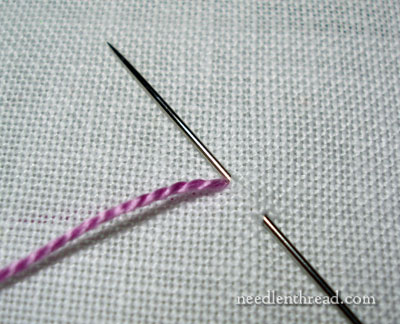
The embroidery thread that I’m using in these photos is perle cotton, which is an s-twisted hand embroidery thread. You may wish to read a little bit about the differences between s-twisted and z-twisted embroidery threads, and take a look at the photo comparison between stitching with an s-twisted and a z-twisted thread, to get an idea an idea of the differences between the two types of thread if you aren’t sure what I’m talking about or would like to know a little more about it. And if you’re not familiar with the bullion knot and how it is made, you are welcome to take a look at my bullion knot video tutorial or to consult any number of stitch dictionaries that may help you see how the stitch is formed, step-by-step, as this is not actually a tutorial on how to make a bullion.
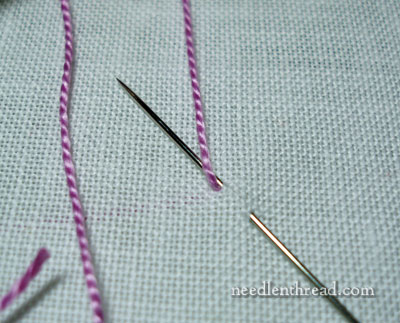
I’m using a milliner (or straw) needle here, which is the ideal needle for making bullions. In making the stitch in the photo above, I’m wrapping the thread clockwise around the needle, or in this case, with the needle pointing up in the fabric, I’m wrapping to the right as the thread passes over the needle.
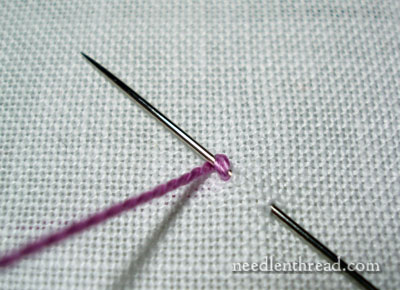
As the thread wraps under the needle, it is going to the left. The thread is wrapped around the needle the required number of times to make the bullion knot the length you want.
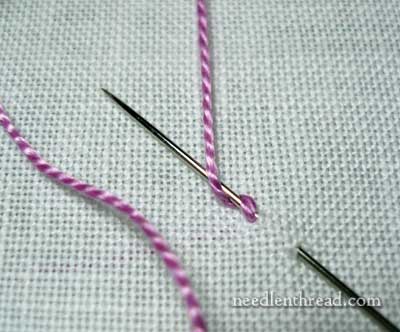
Keep an eye on the working thread. It’s looking pretty healthy in its twist, right?
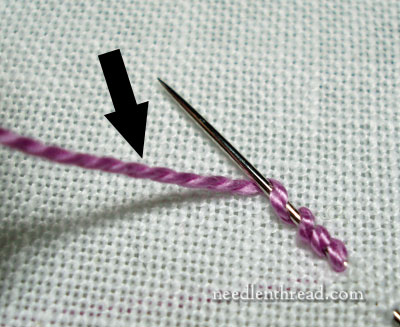
If you look at the thread at this point (where the arrow is pointing), you can see that it is maintaining its twist.
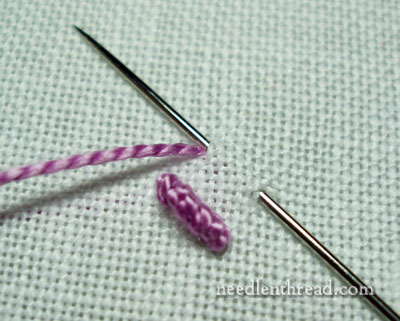
The bullion knot in the photo above is the one created in the steps of the previous photo. And now I have the needle in position to start another bullion, but this time, I’ll wrap in the other direction.
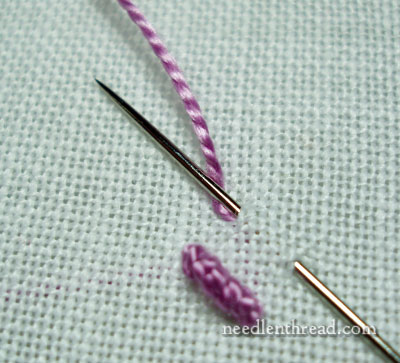
So now, I’m wrapping counter-clockwise, passing the thread under the needle to the right….
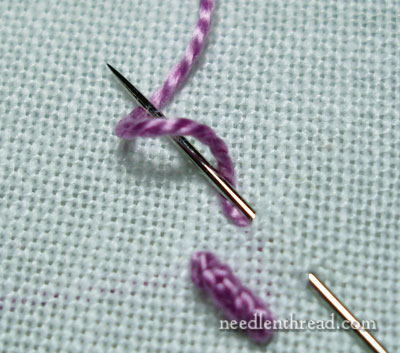
… and over the needle, to the left.
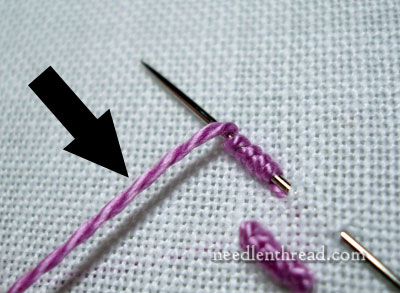
As the thread is wrapped around the needle, notice what’s happening to the working thread. The twist is stretching out and the thread is losing its tighter twist.
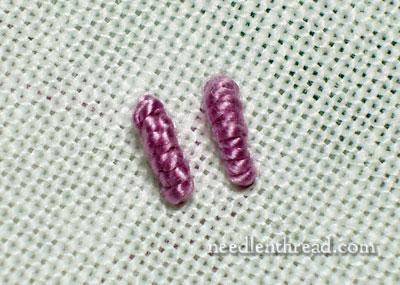
The knot on the left is not quite right because I pulled too tight at the end, ending up with a tapered knot… though sometimes, a tapered knot might be what you want (for certain types of flower petals and so forth). Still, aside from the difference in the overall shape, you can also see that the threads wraps look different. The knot on the right, which untwisted the thread as I worked it, looks like it has more wraps on it (it doesn’t) and overall, looks smoother. The knot on the left, which kept the twist of the thread, shows more definition of the perle cotton.
Now, if you are working with a z-twisted thread, to get either look (the right knot or the left), you’d have to twist the thread in the opposite direction shown above – because this is just one more proof that there is a difference in the outcome of the stitch, depending on the type of thread you’re working with!
So the question is, what look do you want in your bullions? Do you want a smoother, softer look? Or do you want a well-defined wrap? It’s really up to you! Changing the direction of the wrap is an interesting way to achieve a varied look in your bullion roses, flowers, and whatnot!
Try it! Play with bullions and see which direction of wrapping you like best, or how you can combine the two to create a subtle difference within an element made up of bullions.
And now, your turn! When you make bullions, which direction do you automatically wrap the thread and why? Or is it something you’ve never really thought about? And who would blame you?! It’s a tough stitch to get consistently right, and it takes practice to make beautiful bullions! A bullion’s a bullion – why complicate things?!? (Go ahead! You can say it!) Feel free to leave a comment with your thoughts!







Dear Mary
I am a retired lady and wanted to take up a craft, so I sent of for some cross stitch Christmas cards which I completed in time for Christmas and gave to various members of my big family. Since I found your fantastic web site and learning from your how to video I have made a Monogram letter M and I recently tried several stitches on a table cloth I had. I’m now going to attempt another tablecloth with your tulip and leaves pattern.I love the coral stitch and have attempted fishbone, stem, turkey work, chain and various others
Thanks for your comments on the Bullion stitch. Since I watched your video on the rose bud I have made several of them but I have difficulty pulling the thread through the needle after wraping around the needle. I realise I’m using the wrong needle. I’m going to invest in straw/millner needles but I need to know what size to buy or can I use any size.
Anita
I never thought of direction when I wrapped my bullions. I will certainly pay closer attention to both my threads and the direction wrapping in the future. I love doing bullions but never liked the inconsistency of the results. Thank you for a good lesson.
Cathy S, Remus MI
I can’t even manage to do a french knot after 10 years of cross stitching, I always take the cheats way out and use seed beads. Some how I pull the knot the whole way though or it just doesn’t knot! I would love to master embroidery knots, I have the A-Z Embroidery Stitches book and they have beautiful bullion knot variations.
I just wanted to say how much I enjoy and appreciate your information. I only found your site a week ago and can’t wait to read your daily posts. Keep up the great work.
The biggest problem I have with bullion is finding the dratted milliner’s needles! Either I order online (which I loathe doing for something so low in price, which leads me down the dangerous road of browsing the whole needleworking site LOL!) or go without.
Without can be quite the challenge…ideas?
I’ve always wrapped clockwise, I’ve never used Z twisted threads, and I haven’t made enough Bullions to make me a “Bullionere”. I need more practice and a straw needle because up until I started reading your blog, I never knew you should use a different type of needle when you make Bullions! Now you’ve added S and Z twisted threads and wrapping in two difference directions. Geez. Now it’s up to me to practice, practice, practice. Thank you Mary. I’ll be a “Bullionere” before you know it.
Hi there Mary,
Well, I have to admit to doing it the second way……….but I thought that was clockwise??So, I am a dumb blonde.
I also wonder if I prefer doing it this way, as I am right handed and it just feels a more natural way for me to do it.
Have to say practice makes perfect with bullions, I have just finished doing 75 of them for a little handbag I am in the process of making.
Will be interesting to learn which is the favoured way around and why.
Thanks for sharing. This is helpful in that it shows a blunt & sturdy looking petal and a satin delicate petal. What a difference!
Good morning, everyone! Thanks for your comments!
Marysia! Funny – I always have to pause and think about clockwise and counter-clockwise when it comes to wrapping the thread. See, it makes a difference if your needle is pointing upwards towards the top of your fabric, or downwards, towards the base. I think. There I go again, pausing and thinking….
Brenda – thanks for the chuckle. I never thought about being a “bullionere” but it sounds like a good plan to me! You know who makes beautiful bullions is Yvette Stanton. She’s currently working on a book on Portuguese embroidery, which involves lots of bullions, and the sneak peeks she’s given of her samples are really stunning!
Ah – Pam – the question of finding milliner needles. I usually buy needles in “bulk” (a large order at a time) through Colonial Needle, every couple years or so. I lay in an estimated supply of what I will need for my own work and what I will need for students’ work, when I have a class in the offing. Another place I’ve found milliners lately is quilt shops, in their notions sections. Not JoAnn’s or chain stores like that, but local quilt shops. And pretty much, in the two or three I’ve been to in the past year, all of them have carried milliners. So it might be worth looking at a local quilt shop that has a variety of notions available! You can use a crewel needle for bullions, but you have to do a little loosening up of the thread to get the eye through… and this often leads to tapered knots, because they tighten up towards the base sooner than they do in the middle.
Thank you, Eileen! I’m glad you’re enjoying it!
Hi, Fiona! Making French knots is a lot like learning to ride a bike. Once you “get it”, with a little practice, it becomes easy and effortless…. unless you happen to be going uphill, at which point my analogy about the bike limps a bit! The A-Z bullion book is great! I love all the different motifs in there – besides the flower! The clowns, bears, bees, so forth….
Hi, Anita – The best bet for purchasing milliners is to get a pack that has a range of sizes in it, from 3-9. That way, you have your bases covered. John James makes a combo pack like that, which they carry at Colonial Needle (www.colonialneedle.com). Just search “milliner” and you’ll see everything they offer in the way of milliner needles. The size of the needle depends upon the size of the thread you’re using, so for heavier threads, you’ll want the lower-numbered sizes, and for finer threads, the higher-numbered sizes.
Thanks, Cathy – glad you like the tip!
Ok, I’m off to work. Ice and snow here in Kansas, after a beautiful 70 degrees yesterday! Enjoy your day!
Well, it’s going to be a rainy day here today so I think you’ve inspired me to work on buttonhole and bullion stitches in different directions. I’ve never really given it much thought on direction but I will add some today to my crazy quilt.
Hi There,
Until now, I equated S & Z with snooze. You have given me an entire dictionary of things to think about. For instance: I have been told that I stitch like a left handed person! Maybe I am dyslexic? The nuns did it to me years ago. My mom swears I have always been a right handed gal but I think she fears I will blame her for this malady and cannot remember very well at this stage of the game anyway. Previously, I would just sit down and go at it. Now I have to have a piece of practice cloth just to see if I can form the stitches right to left or left to right. Now I need my books of instruction. I have to examine the threads I am using. I gaze at them like they are the seveth wonder of the world. My husband thinks I have truly lost my marbles! LOL. I do love your tips. When you picked out that leave I was here screaming, NO, NO, NO! I wanted to rescue it like an abandoned child. You keep life interesting. Thanks for writing this column. I so look forward to you and your brain food. Chris Beresford
Thank you. I have never even thought about what way to twist the thread on a bullion just did it whatever way but looking at your examples I can clearly see what a difference it makes. I am learning so much from your site.
I have been “watching” with interest the difference in direction. The other day you showed the difference in appearance in blanket stitches and today’s knots: As I am a left-handed stitcher, I couldn’t even imagine trying to do blanket stitches “backwards”, but if you can, then I guess I should be able to do it too! The knots have never been my favorite, but they have their place, even in counted work which is my favorite. I will try to make my left hand be more adaptable to “the other way”. Thanks for your tips, I really enjoy them. Judi
I make mine the way you do. I have enjoyed the discussions of s and z twisted threads. I took a sashiko class and asked the instructor if the thread was s or z twisted. She didn’t know and it may not matter. I have an ever-growing collection of books and have discovered a couple that state stem stitch and outline stitch are the same. I may have to deface them 😉
I am embroidering a baby blanket and using mostly stem stitch, in part because I love the way it looks in the back. I have a question I haven’t come across. How do you start and finish tiny areas of say just a few French knots that are not close to other stitching?
Dear Marymentor”
Thanks so very much for this one. It was helpful, informative and your use of pictures keeps me “tuned-in” every morning when I first arise and start to toddle around in the (yes…still !) Pittsburgh snow.
The pastoral I’ve been working on since GOD CREATED THREAD is only about half done. I keep picking my brain for tricks, techniques, etc. But thanks to your blogs or website or whatever this is called (?) your are always a source that gets my creative juices/synapses firing ! I know just where I can use the bullion stitches ! They’ll work perfectly to create the “blossoms” on a wysteria vine ! Thanks again….Judy in Pittsburgh <3
I haven’t tried bullions yet but want to. The blog you did on “S” twist and “Z” twist has been very helpful to me. And I can see where it would make a huge difference in bullions. The second one to the right kind of reminds me of a bug. I like the one to the left better. I wonder how much difference the twist would make in French knots. I remember thinking you wrap your thread the opposite of the way I do it. But then it didn’t seem to matter that much. I may have to play with that, see if the right wrap makes a neater French knot, like a tiny rosebud.
Thank you very much. This really help.
Have a nice day
Sonia
I use my left hand to twist the thread on to the needle,from left to right, I love these knots. Never thought of twisting the thread the other way, I should try it.Someone mentioned to me that Braziliam embroidery, uses this technique a lot in their beautirul work.
Good article and demonstration of the wrap direction of a bullion with S twist and Z twist thread. We seem to have a different way of calling a wrap clockwise or counter clockwise. Those of us who do Brazilian embroidery always tell our students to wrap clockwise with Z twist, explainiong that if you are looking at the point of the needle the thread wraps around like the hands go around the clock. This is what you called counter clockwise.
Hi All! Thanks again for your comments! Loretta – I think (I could be wrong) that it’s because I’m looking at the needle kind of from the back, rather than “face on” at the point. I could be wrong. Moving to the right over the needle, when the needle is pointing towards the top of the fabric, the circle made by your hand as you twist is clockwise. But I’ll play with it to see if I’m calling it the wrong direction! Which could actually be the case!! 🙂 MC
Oh my, I just stumbled over this site while resarching blackwork for a funeral pall that I am about to embroider and what riches have fallen into my lap. As a young embroiderer, this is such a treasure. Thank you for sharing patterns, wisdom and techniques. I am self taught from books and exerimentation (and from Inspirations magazine) but there is so much still to learn!
Hi, Eva – Thanks for stopping in and leaving a comment! I’m glad you find the site useful! A funeral pall is a big project – best of luck with it! ~Mary
It is a big project, though luckily it is not a full sized funeral pall, but a cremation pall. Still, it is the first time I am tackling a project this big. Thank you for the well wishes!
Thank you Mary for revisiting the bullion stitch and blanket stitch.
Your way of analyzing the directions of stitches and thread twist are so helpful.
Diving into the more “nitty gritty” part of embroidery details is very interesting and becomes a very useful tool.
Thanks for taking the time and sharing it ….
Hi Mary,
Love It!!!
As a rightie who stitches lefthanded, it has been on my mind about ‘am I doing it the right way.’
Knowing myself, if something doesn’t look ‘right’ to me, I’m more than willing to frog. and frog. and frog.
I appreciate all the you are sharing and teaching on this site, Mary! Thank you!
Hi Mary,
Thanks for the insight – I see now one of the reasons my knots are inconsistent. I the other problem I always have is pulling the needle through while keeping it wrapped. Any suggestions for that?
As always, I enjoy your writings and always learn something!
Kathy in Kenai
Hi, Kathy! I keep my thumb over the wraps until I pull through. This seems to work pretty well! If the wraps are too tight, and you can’t get your needle through with your thumb over the wraps, instead of removing your thumb, roll the needle back and forth between the thumb and finger (on the hand you’re using to hold the needle) while keeping the thumb lightly in place on the wraps. This will help loosen up the wraps. Then, pull through in an upwards direction (or in the same direction, actually, that your needle is coming out of the wraps) until the thread is all the way through. Give a light tug after the thread is all the way through, then remove your thumb, and then take your needle down into the fabric at the end of the wraps. You can use your needle to nudge the wraps a bit or to stroke the stitch a bit, to get everything to lie in place. That’s how I do it! Hope it helps! ~MC
This is really helpful. I wasn’t entirely satisfied with the bullions I made in a recent piece (the first time I’d tried them), but I didn’t know why. I wonder if I’d have liked them better in another direction. Of course I’ve given the piece away, so I’ve no idea how I did them, but at least I’ll know to experiment next time.
Hello Mary,
I was wondering about the fabric you are using on these photos and what count?
Looks very nice quality …
Thanks in advance!
Hi, Suzanna – I was using a “scrap” piece of Sotema linen from Italy. I believe it’s the 20L, which is a 38 count linen. It is a very nice linen! ~MC
Thanks for the info Mary … it sure is beautiful and caught my eye.
Now I have to put it on my shopping list 🙂
Mary! I find your discoveries with stitch fascinating – I’ve taught stitch for 20 years and I’m still learning (from smart folk like you!). I just wanted to let you know that I lived in Kansas with a wonderful family in Winfield (I’m English and I was an exchange student 30 years ago). Ironically, I visited last summer and stayed with my US host family at their homes in Winfield and Wichita. I’m coming to see them again in 2012 with my English mum, we’re planning to go to the Bluegrass Festival. It’d be great to come and see you at the same time?
Best Wishes, Nicola
Hello Mary!
I have been silent but always reading your posts by e-mail of course 🙂
I have a different way to name the directions I would call the direction of the second bullion clockwise – the direction the clock hands work (here considering the needle the center of the clock) make this any sense??!!
I make the bullions just as you did the second one. The same way those zillions of bullions in Portuguese embroidery (Guimaraes Embroidery) are done in Perlé 8 😉
and I’m loving your wool embroidery! The leaves are wonderful
xxMeri
Thanks for the vote of confidence Mary! Your website is my special “escape” for the day. When my baby is sleeping I pop in for a visit to see what you’re up to. It gives me a sense of self to be reading/seeing the things that I enjoy (that aren’t baby or housework related!) I know you’re a busy lady, but I wish you had more stitching time because I just love watching your projects unfold! The pomegranate and the jacobean jumble have me fascinated. I just don’t know how you look at a pattern and “see” what colours and stitches you want to use. Do you have a creative process? I would like to be able to unlock a little creativity in myself-I am great at following patterns and instructions, but not so good at using my own imagination!
Hi Mary,
I just wanted to mention to Fiona and others what I have found with French knots. Like Fiona, I always had trouble making them, especially since I often use perle cotton, which is slippery. I then stumbled on a stitch dictionary with the Colonial knot, which is very similar and, I think, easier to do. I usually use that now with the cotton, but I have found that I seem to have no trouble making French knots with wool thread.
I love your site and thank you so much for putting so much time and love into it. Your style is perfect for learning the right way to do things. Have you ever been to the Royal School of Needlework? What I would give to be able to take classes there!
Keep up the inspirational work!
Jennifer
Hi. I stumbled upon your site while looking (in vain) for an ebay item that I wish I’d saved. Have you ever done that? Seen something so beautiful and breath-taking, and thought, oh, I’ll just go back to it? And now it’s gone. Can’t find it on ebay, have googled ebay, etc. and now am reduced to looking online for something similar. Anyway, it was a gorgeous white on white, vintage, probably French embroidered piece. What was so astonishing is that it had a floral motif, which I don’t usually care for, but the work was so realistic, yet so artistic at the same time. The rose had petals which were tapering bullioned stitch, with such mastery yet such abandon. I’m sure it was padded, because the work was three-dimensional. OMG, what I wouldn’t give to find that piece again. But of all the people I’ve seen on the internet, you look like you’d be the person who would know about it, or be able to reproduce that stitch. It was so so so so fine, and so is your work.
Hi, Nancy! Thanks for your comment! Yep, I’ve done that too many times to count! I’m not sure of the piece you’re talking about, though. There are so many things that come and go online, it’s impossible to really know all of them. Are you looking for another vintage piece that you want to purchase, already stitched, or are you looking for the design to stitch yourself? I’ll let you know if I stumble on anything that sounds like what you’re talking about!
~MC
Hi, Mary. Thanks for the prompt reply. My fingers are like sausages thanks to neuropathy and bilateral carpal tunnel. But the price would be prohibitive, I’m sure. Don’t remember, but a fine piece of work like that, vintage, master craftswomanship? I’m guessing that for a retired teacher like me, it’d have been out of my reach. To tell you the truth, I think I just want to find the picture and look at it! Sound weird? But it was so beautiful, almost sculpted…if I find it, I’ll be sure to sent you a copy, and I’d love it if you’d do the same–that is, finding something similar:-)
Hi, Mary! Don’t know if you have an ebay account or not–hope this will be accessible. This is the closest I’ve come to finding anything that looks like what I was telling you. Still, the linen isn’t as fine, and the embroidery work isn’t as daring or accomplished. FYI:
http://cgi.ebay.com/ANTIQUE-HANDWOVEN-FRENCH-LINEN-SHEET-mono-CC-/300530197225?pt=LH_DefaultDomain_0&hash=item45f8fee2e9#ht_3056wt_1293
If you can’t see this page, I could send you some pictures. BTW, I see you’re in KS. I was unable to find a contact number for you, but I live nearby in Missouri. If you still give classes, I’d love to take a stab at it; hahahaha–poor pun indeed, but that’s what I’d be doing with my sausage fingers–stabbing myself:-)
Nancy
Hi, Nancy – OH WOW. The sheet is gorgeous. What a work of art! Slightly out of my price range, but so far, I think the bid is reasonable. It’s really beautiful!
I’m about 3 hours west of KC – not “too far” from the city to enjoy a day there now and then, but far enough that driving to the airport is a Pain in the Neck! 🙂 I’m not giving classes currently – a little busy with the school year – but I may start them up again in the future. If I do, I’ll announce them! You’re right – there is a lot of Kansas and a lot of MO between KS & MO! What part of Missouri are you in? Have you considered looking up the EGA (Embroiderers Guild of America), and seeing if there is a chapter nearby? They often host classes with excellent teachers!
Best,
Mary
Well, I THINK I live nearby, but as you and I know, there could be a lot of Kansas and a lot of Missouri between KS and MO:-)
I live near Holt, Missouri, which is about an hour north of Kansas City (depending on the traffic). I could get in touch with the EGA–thanks for the suggestion!
Now you see what I mean about the work, since I’m guessing by your reaction that you saw the ebay site:-) And I consider that only less than half of the craftswomanship of the one I really love, and can no longer find.
Thanks so much for sharing your love of the material and the craft with the rest of us, Mary. What a gift! I love your pomegranate embroidery, by the way.
Nancy
Don’t mean to tie up your band-width here, Mary, but here’s another url that I thought you might enjoy. Maybe you could change one of the Ms to a C?
http://www.flickr.com/photos/30717951@N03/3222624405/in/photostream/
What about Bullion loop flowers with many (50) wraps as in Brazillian embroidery? There is a big mess when i stitch them… Either the knot comes off the fabric or it is impossible to pull off the wraps off the needle. Please reply
Thanks
You are right. This stitch is going to take a lot of practice to get just right. I’m wondering if it is possible to do this stitch using two or three strands of embroidery floss?
Oh yes, you can work it with practically any type of thread. Three strands of floss look great!
Your videos are so easy to follow. I will be using the techniques in Needlepoint. Thank you.
Hi,
I am looking for a bullion pattern to make giraffes. Do you have any websites I could check out for this please. Thanks.
Hi, Jill – You might check out the book called A-Z of Embroidery Motifs, which is a book devoted almost entirely to making little embroidery motifs out of bullion knots. They have a lot of animals in there, but I don’t recall if there’s a giraffe. Still, the techniques used on some of the other animals could be helpful in concocting your own giraffe, so it might be worth it. Here’s my review of the book: https://needlenthread.wpengine.com/2015/03/a-z-of-embroidered-motifs-the-bullion-book.html
I love your tutorials and learn so much on stitches I didn’t even know existed. Thank you so much for your help. I have a question about the bullion stitch tutorial. I have found this stitch really difficult but I’ve used a different method and yours looks much easier. My method leaves the fabric out of the hoop. In your method is the fabric in the hoop? Sheiliagh